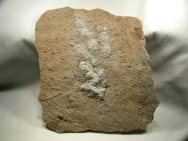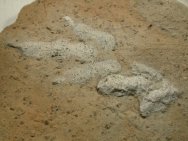Grallator tenuis (dinosaur tracks)
Geological Time: Late Triassic/ Early Jurassic Lower Lias, Rhaetian Age (~200 million years ago)
Size: 80 mm by 60 mm and 60 mm by 45 mm on a 235 mm by 205 mm matrix
Fossil Site: Veillon, France
This fine pair of casts is of the ichnogenus Grallator (heron-foot), first described by Edward Hitchcock in 1858. The first tridactyl print was discovered in the Connecticut Valley 1802 and was attributed to “Noah’s Raven”. These bird-like tracks are thought to have been made by a coelurosaurian theropod similar to Coelophysis. Notice the fine details seen here that include the impressions of the claws and footpads on the larger example. Also see: Dinosaur Fossils |






